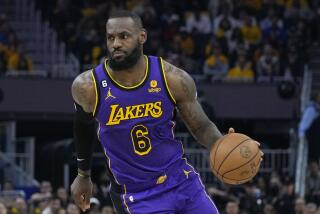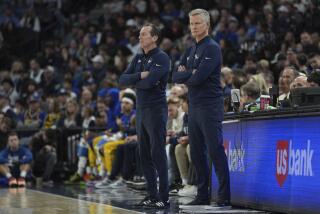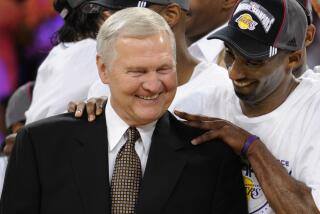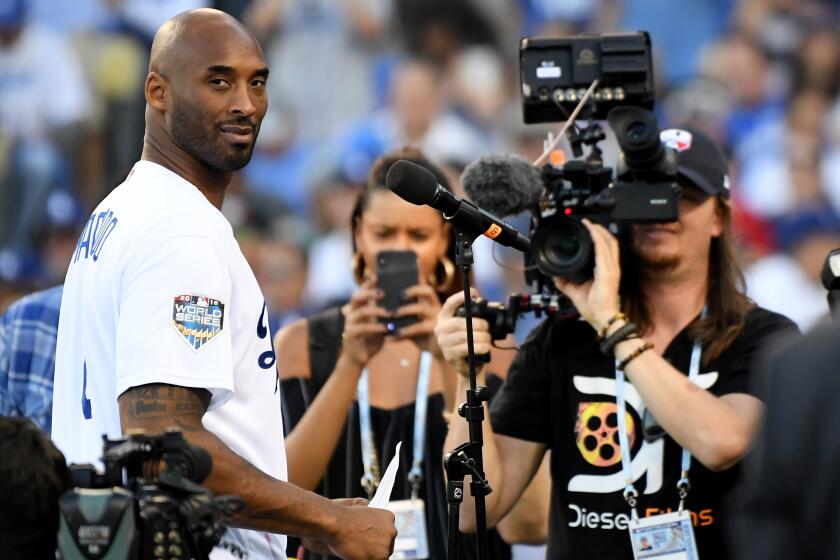THE RIGHT ANGLE
It’s a new chapter in Laker history, with a new coach who brings with him an exotic new offense that comes all the way from . . .
Jefferson and Figueroa?
There in the Shrine Auditorium, USC’s basketball team played most of its home games in 1946 with a squad that included a little senior guard named Tex Winter, a hotshot freshman named Bill Sharman and a returning Army veteran named Alex Hannum.
The coach was Sam Berry, who ran something called “the center option,” a forerunner of the offense Winter would devise, the “triangle,” that he taught the Bulls under Phil Jackson, after which they won six NBA titles in the ‘90s.
Hannum also used it with the 76ers, who won an NBA record 68 games in 1967. Sharman’s Lakers then won 69 five years later, using some triangle, a record that stood until the Bulls won 72 in 1996.
“The funny thing was, we didn’t win with it,” says Sharman, remembering their days at USC. “We were 10-14.
“Then Hannum plays it with the 76ers and they win 68 games. Then we used it a little bit with the Lakers and we win 69. Then Tex runs it with the Bulls and they win 72.”
Of course, the 76ers had Wilt Chamberlain, Billy Cunningham, Chet Walker, Luke Jackson and Hal Greer. The Lakers had Wilt, Jerry West and Gail Goodrich. The Bulls, who eclipsed both, had Michael Jordan, leading some skeptics to describe the triangle as “three ways to get the ball to Jordan.”
Nor were skeptics hard to find in a league in which almost everyone runs the static “pro set,” in which the offensive team throws the ball to its best post-up player--an easy matter since the rules limit sagging and bar double-teaming off the ball--hopefully forcing a double-team which leaves three defenders on four offensive players. In practice, few players move and teams go deep into the clock, as the defense waits as long as it can to double-team, running the offense out of time.
Also, in practice, scoring went into a steep, decade-long decline in the ‘90s when the pro set became the standard.
Nevertheless, it’s easy to run, compared with the fluid triangle, which has no set plays, only passes and cuts, with players constantly forming triangles, all based on reading the defense.
In recent years, Jim Cleamons, a former Bull assistant who has rejoined Jackson with the Lakers, installed it in Dallas and was fired soon thereafter. Cotton Fitzsimmons, a Winter disciple, put it in in Phoenix, started 0-8 and promptly retired for good.
“You can’t run a continuity offense in the NBA,” says a former assistant coach. “The problem is the 24-second clock.
“The Bulls couldn’t have done that without Jordan. How many times did you see the 24-second clock run down at the end and then Michael save them--15 times a game?”
Nevertheless, purists love the triangle. San Antonio Coach Gregg Popovich, who uses the standard NBA dump-it-in scheme, once sneered at his own offense, noting one of his reserves, former Bull Steve Kerr, had recently run “ a real offense,” as opposed to “this pro thing” the Spurs were using.
“It [the triangle] is the best offense in the NBA from my point of view,” says Pete Newell, former California coach, now a Cleveland Cavalier consultant.
“Offensively, players are moving all the time. That makes it hard to double the ball. It makes it difficult to help out because you’re worried about somebody picking you off.
“One of the reasons Michael was as great as he was, the spacing was always so good, it was very difficult to double-team him. You have to go quite a distance to get a second man on him.
“Of course, Michael would make any offense look good but no other offense would have made him look as good.”
In fact, the Bulls’ opponents found they were doomed if they double-teamed, and also if they didn’t.
After Jordan made a last-second 20-footer in Game 1 of the 1997 finals, Utah’s Jerry Sloan was criticized for playing him one-on-one. In a similar situation in Game 6, Sloan sent a second man at Jordan, who quickly passed to Kerr, who knocked down the series-winning shot.
OK, now all the Lakers have to do is become the second team in the ‘90s to successfully put the triangle in, and time’s running out.
Goes Around, Comes Around
After USC, Winter became an assistant at Kansas State under Jack Gardner, another Berry pupil, and ultimately the head coach there. Tex started refining his theories of offense, based on things he had learned from Berry, Newell (for whom he’d once been a ball boy at Loyola) and another great, Everett Dean and published “Triple Post Offense” in 1962.
His later career included stints coaching the San Diego Rockets (hired by Newell, then general manager) and Long Beach State. He was semiretired in 1985 when Jerry Krause, a young scout he had befriended, became the Bulls’ general manager and brought the 63-year-old Winter to Chicago.
Krause’s enthusiasm for the triangle wasn’t shared by Krause’s pro-style coaches, Stan Albeck and Doug Collins. However Jackson, taking over in 1989, had played for the Knick champions in 1970 and 1973 that were known for unselfishness and movement. In Chicago, where Jordan owned the ball, Jackson wanted an offense that would engender a new spirit.
“We were together as assistants,” Winter says, “and we used to talk about how stereotyped pro offenses were getting. He was looking for a system that was similar to the way they played in New York, when he played there, when they won those championships. That was a team that read defenses beautifully and moved the ball.
“I just think I happened to be at the right place at the right time. He embraced it. I was very fortunate to be there or I probably would have been long ago retired.”
Jordan, who couldn’t understand why it was better to have the ball in Horace Grant’s hands than his, called it an “equal opportunity offense,” which he didn’t mean as a compliment. Nevertheless, Jordan tried it and the Bulls caught on.
(Not that Jordan gave up, entirely. Before their second season, Jackson noted no scoring leader’s team had ever won a title. Jordan proceeded to become the first, leading the league five times during six title runs.)
“It was very simple,” says West, who ran the triangle in the ‘70s. “This offense to some degree is simple but players have to change their thought process a little bit. It becomes a little more of an instinctive thing. . . .
“It was an offense we really designed more for centers, because centers touch the ball a lot. Chicago didn’t use it that way because when it got down to it, Michael Jordan really was kind of a post player for them.”
Of course, instincts aren’t what they used to be since NBA players are so rarely asked to read defenses and think on their feet any more.
The Lakers last season traded Elden Campbell, a big, talented player, because he couldn’t figure out how to complement Shaquille O’Neal. When the defense rotated toward O’Neal, all Campbell had to do was cut to the basket for a pass, crash the boards or drift to an open spot. Instead, mostly, he watched.
In Chicago, as the Bulls eventually learned, some players picked the triangle up right away. Some would be lost for a few weeks. And one or two were never found.
“I think it’s pretty simple,” says Kerr. “It’s just so different from what everybody’s used to playing. Most teams come down, call a play and everybody runs to their spots and they make the pass where everybody knows it’s going to go.
“In the triangle, five guys get to their spots but you can pass to any of the four guys. When you make the pass, there’s a cut. It depends on how the defense plays you.”
And if Jordan still winds up with the ball whenever the clock runs down or it’s crunch time?
“That’s kind of the beauty of it, even though people kinda laughed at it, it allows players to get into a position to bail their teammates out,” Kerr says. “I think Kobe [Bryant] is going to enjoy that and Shaq will enjoy it as well.”
Well, after a while they may anyway.
Summertime Blues
Of course, the Suns were a downtrodden crew, just starting out on their post-Charles Barkley era when Fitzsimmons tried to put the triangle in.
Likewise, Cleamons’ Mavericks had just traded the last of their three J’s, and the franchise didn’t revive after Don Nelson canned him and his triangle.
Neither was the Laker entry in the recent summer league at Long Beach State any powerhouse, so you can’t blame the offense, entirely anyway, for their 1-6 record.
Of course, in the beginning, they were pretty confused, all right, or as No. 2 pick John Celestand said after the opener, “It’s a mystery and only Phil knows.”
And Phil was headed back to Montana, leaving Cleamons to instruct the Laker youth. By their last game, they seemed to be running the offense better although you couldn’t say they looked impressive in a 116-76 loss to the Orlando Magic.
“I mean, it’s not as hard any more,” said Devean George, the No. 1 draft pick, who finally figured out ways to get off shots, even if they all came from 20 feet out.
“I’m glad I came here for these two weeks so when I come back in October, all the veterans, they’ll be at Day 1 and this will be kind of like review.”
That should be something to see because the first thing the veterans will have to learn . . . is all the things that they have to unlearn.
“It’s based on a player’s instincts,” Cleamons says. “If a young man has been taught well, [by] high school, college or even great coaches at the pro level, this is really a very functional offense. But you’re relying on your teammates and in these days, everyone wants statistics and points and minutes and shots and all this, and that doesn’t lend itself to the team concept. . . .
“What we found out there [in Dallas] was, veteran ballplayers, especially if they’re lacking in certain skills, they want to shy away from it and want to play more of the pro set. . . . Well, that concept is totally opposed to the triangle and when you ask guys now who are in the rut of pro offenses, they don’t have the skills or the desire.
“You have to have an open mind and an open heart to really run this and have success, because you are depending upon your teammates and some guys don’t have that trust factor.”
Unlike Cleamons, who could feel the griddle heating under him in Dallas, and Fitzsimmons, who was back for a last coaching stint as a favor to his owner, the Lakers aren’t an underpowered team wondering how short-term their coach is.
They have firepower. They have players who can get shots on their own if they have to. They have a coach with a five-year $30-million contract.
It’s not that Jackson will necessarily need that long to teach them the triangle, but it’s good he has it, anyway.
(BEGIN TEXT OF INFOBOX / INFOGRAPHIC)
TRIANGLE OPTIONS
The Lakers Will Have the Same Offense That Helped the Chicago Bulls Win Six NBA Titles--Minus Michael Jordan, of Course. A Closer Look at Some of the Basic Plays of the Complex Scheme L.A. Will Run:
More to Read
All things Lakers, all the time.
Get all the Lakers news you need in Dan Woike's weekly newsletter.
You may occasionally receive promotional content from the Los Angeles Times.







